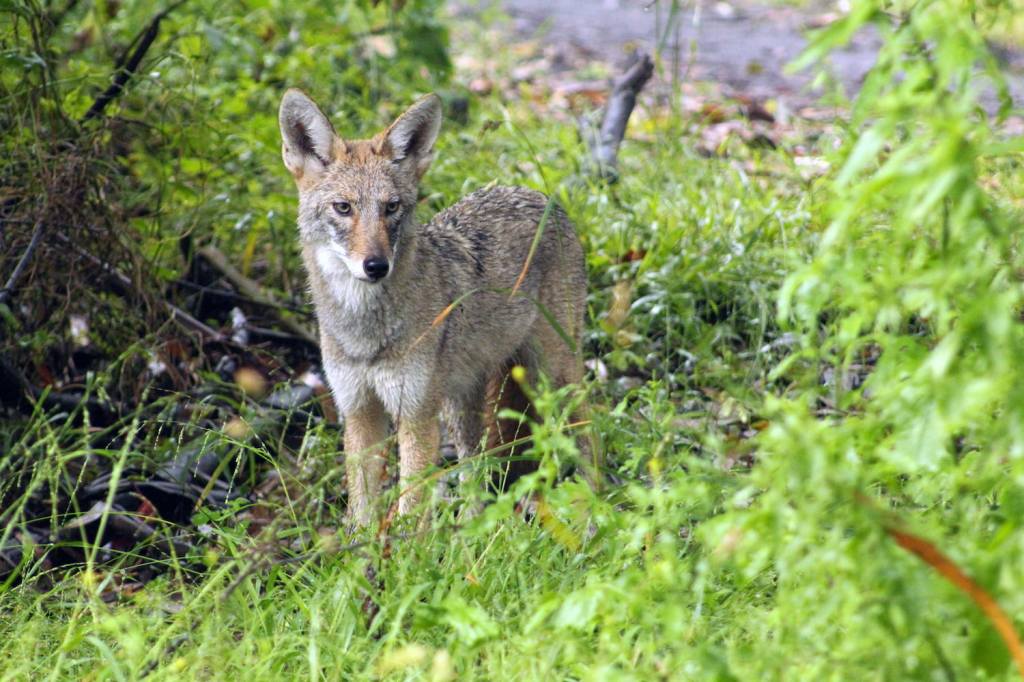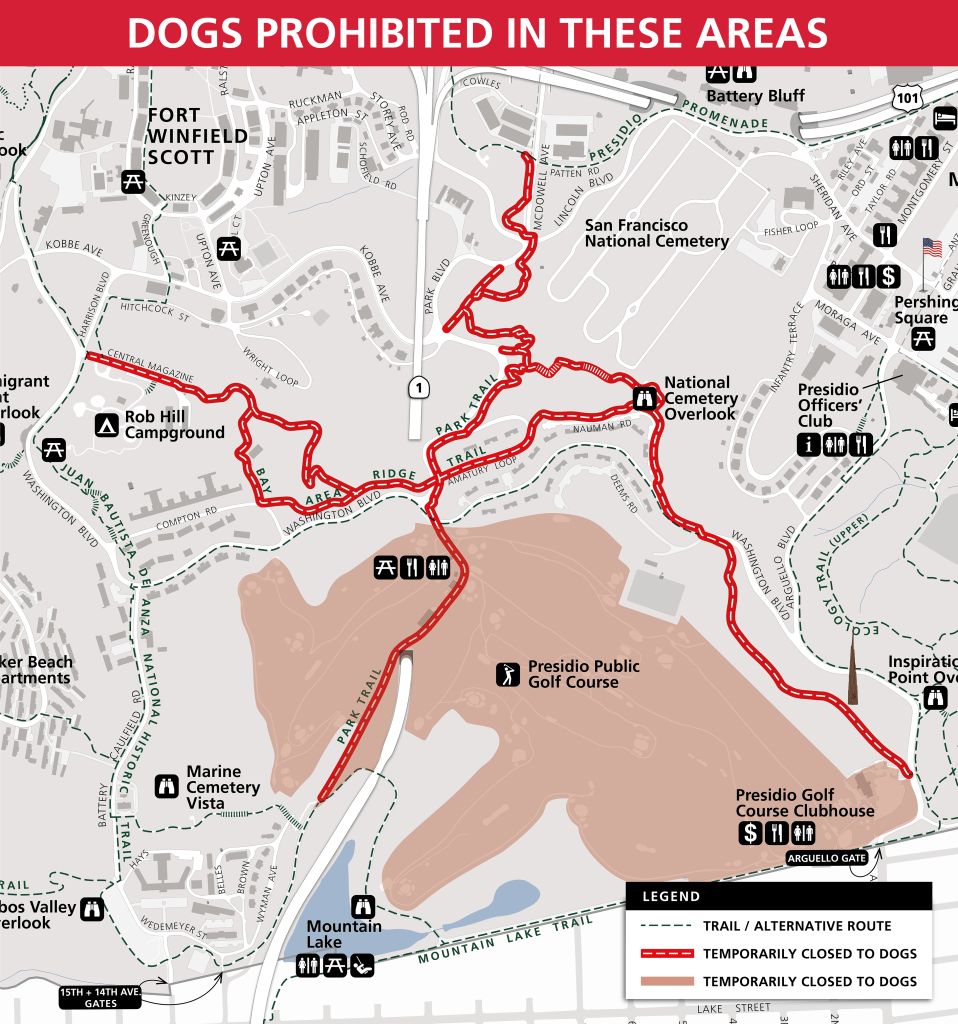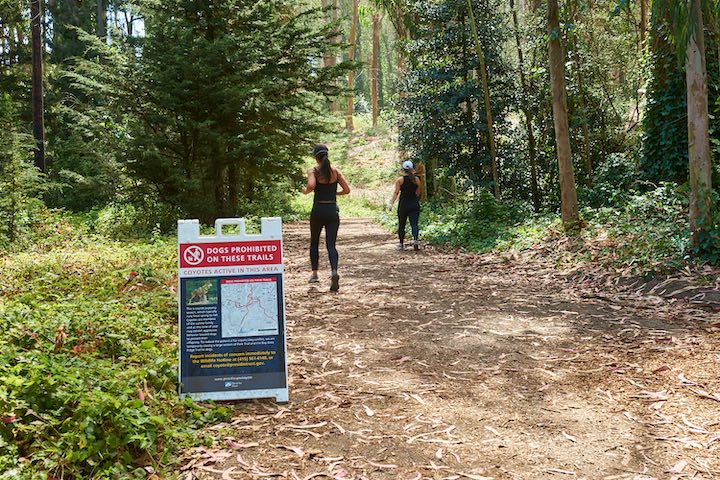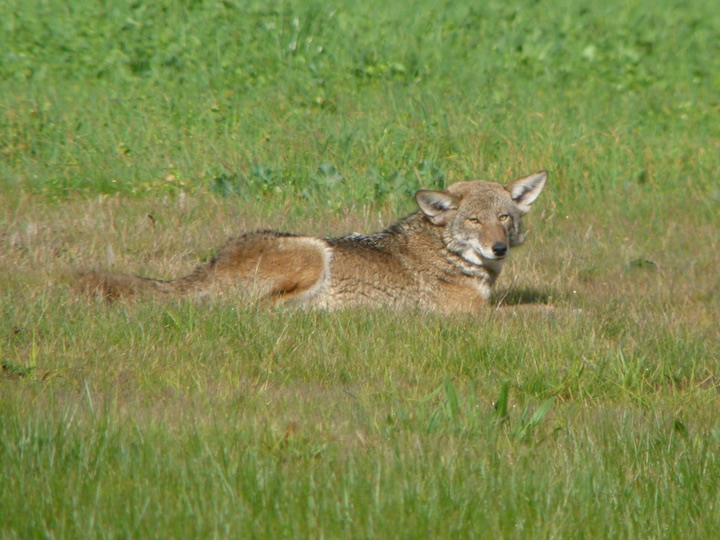Coyotes in the Presidio
Learn how we manage coyotes and work to support the co-existence of people and wildlife.
After a long absence, coyotes returned to the Presidio in 2002. They’re also seen in Marin, Golden Gate Park, Lands’ End, Glen Park, and other Bay Area open spaces. Coyotes play an important role in the park’s environment by keeping rodents and raccoons at healthy levels. They’re adaptable creatures and are likely here to stay.
Because the Presidio welcomes millions of visitors and is a place where people live and work, the Presidio Trust has an active coyote management program that includes public education. Our goal is to reduce potential conflicts between coyotes, dogs, and people.
Spring 2024 Update

Coyote Pupping Season
Spring signals the start of coyote pupping season, which typically extends to fall. Though coyotes are seen year-round in the Presidio, spring is when coyote parents are active around and protective of their den site.
As in recent years, we expect this year’s pups to be born in late March to early April and the den site to be located somewhere in the center of the park. We’ve placed signs around the Presidio – especially along trails where coyotes have been active in previous years – to raise awareness about coyote pupping season. Also, Coyote parents may attempt to herd people and dogs away from denning areas, so it’s important to give them plenty of space during this time.
To reduce the potential for coyote/dog conflict, we’ve proactively closed large sections of the Park Trail and the Bay Area Ridge Trail to dog walking (see map below). This annual closure is temporary; we’ll reopen these trails to dog walking in fall after pupping season ends. All 24 miles of hiking trails in the Presidio are open to people – download our Trail map for all trail options.

Dogs & Coyotes in the Presidio
Dogs must be on leash in the park. If you’re with your dog and encounter a coyote, the best course of action is to quickly leave the area. If the coyote follows, be assertive and aggressive (e.g., forcefully throw weighted objects at the coyote) while continuing to walk quickly away. Do not run. Dog walkers should stay aware of their surroundings and note posted signage.
Current Coyote Population
As of March 2024, there’s a breeding pair and the pups that were born in March 2023 have dispersed or are in the midst of dispersing out of the park.
Report an Incident of Concern
Report any incidents of concern (such as aggressive coyote behavior or visitors feeding a coyote) immediately to the Presidio Trust Wildlife Hotline at (415) 561-4270 or coyote@presidiotrust.gov.
Managing Coyotes in the Presidio
In 2003-2004, we began working with other Bay Area agencies to develop strategies to assess wildlife behavior and determine appropriate responses.
Our management actions range from public education to hazing/intimidation to ensure the animal retains its fear of humans to – under very rare circumstances – lethal removal of a coyote evaluated and determined to be a threat to public safety.
With the assistance of urban wildlife managers and researchers across the country – including the National Park Service, U.S. Geological Survey, U.C. Davis, and the U.S. Department of Agriculture – the Presidio Trust developed a monitoring program using modern technology to improve the management of coyotes within the Presidio. It began in 2015 and involved humanely capturing, tagging, health screening, and attaching temporary GPS tracking collars to resident coyotes in the Presidio.

As part of this program, we tagged and temporarily collared sixteen coyote individuals. Fourteen of those animals were pups born in three different years/litters. All fourteen pups have since dispersed from the Presidio, and we’ve tracked their journeys as they tried to find their own territory elsewhere. Many of these animals have not survived the harsh realities of urban traffic.
Over the last several years, we’ve collected sufficient behavioral data to effectively inform our management strategies. Our management efforts continue though we are no longer actively trapping the resident coyotes.
Goals of the Presidio Coyote Management Program
- Minimize dog/coyote conflict
- Learn about the resident coyote population so we can improve our management strategies and reduce coyote and dog/human conflict
- Improve our ability to identify an active coyote den site
- Assess the health and diet of coyotes
- Confirm the number of breeding pairs in the Presidio
- Assess genetics within the context of the larger Bay Area
- Learn about the movement and ultimate fate of Presidio-born pups
About Coyotes in the Presidio
There is one alpha coyote pair in the Presidio. Within a claimed territory, only one pair of coyotes will breed. This bonded male and female are long-term residents of the territory and known as the alpha pair. The pair patrols their territory to keep non-resident coyotes out. The alpha pair remain bonded together for life.
Coyote pupping season runs from spring to fall. This is the period when there is more potential for dog/coyote interactions as coyotes protect their young.
Typically, year-old pups are driven from the parents’ territory, and the resident population – those that remain in the Presidio long term (e.g., the alpha pair) – remains stable. That said, it’s difficult to know precisely how many coyotes are in the Presidio at any given time as individual coyotes can move considerable distances in a single day.
If You Encounter a Coyote in the Presidio
- Keep your distance; do not approach the coyote
- Keep your dog on a leash and under your control
- Observe posted signs about coyote activity in the park
- Supervise children when outdoors
- Never attempt to feed a coyote
If you encounter a coyote within 50 feet and the coyote does not move away on its own, here are ways you can haze/intimidate the animal to help it retain a fear of humans:
- Be as big and loud as possible; shout in a deep, loud, and aggressive voice
- Wave your arms and throw small objects (to scare, not injure)
- Maintain eye contact, which makes them uncomfortable and timid
If the coyote continues to approach, do not run or turn your back on the coyote, but continue to exaggerate the above gestures while backing away slowly. Report this type of incident to the Presidio Wildlife Hotline at (415) 561-4270 or coyote@presidiotrust.gov.

If you encounter a coyote during pupping season (spring through fall) AND you have a dog with you, the best course of action is to back away slowly and leave the area immediately. Coyotes will attempt to drive away other coyotes and dogs from their pups, and hazing may not work.
Guidance for Presidio Residents
Do not leave human or pet food outside where coyotes might eat it. Put garbage out on the morning of pickup instead of the night before (containers need to be at the curb by 6 a.m.). To get a bungee for your trash bin from Recology, call (415) 330-1300 or customerservice@recologysf.com.
Help Us Monitor Coyotes
If you see a coyote in the Presidio, submit a photo and/or report the sighting via iNaturalist through their app or website. Report any identifying characteristics.
We regularly monitor iNaturalist for information on coyote activity, location, and other relevant information (e.g., what was the coyote doing when you observed it? Was it sleeping in the sun, hunting gophers in a field, etc.?).
VIDEO: Coyotes in the Presidio
Frequently Asked Questions
Contact the Presidio Trust Wildlife Hotline at (415) 561-4270 or coyote@presidiotrust.gov.
The Presidio Trust’s goals are to ensure public safety, minimize encounters, and keep resident coyotes wild. To achieve these goals, we promote community education in addition to applying the most current scientific understanding of coyotes. Careful coyote monitoring helps us understand the Presidio’s coyote population and ensure human safety.
Coyotes are adaptable and often live in or near urban areas. They are seen throughout San Francisco and live in most large city parks. The Presidio offers good habitat for coyotes due to its wild food sources, water sources, and green open space. Coyotes feed primarily on rodents and play a valuable role in the Presidio’s ecosystem, primarily through natural pest control.
Coyotes were historically found in the Bay Area due to the abundance of habitat, food, and water. As San Francisco grew, coyotes were pushed out. The last coyote recorded in the city in the 20th century was seen in 1925 in Golden Gate Park. In addition to loss of habitat due to urban expansion, coyotes were historically not socially tolerated and were hunted for recreation and/or control. Coyotes began to return to the Presidio in 2002 and are also seen in other parks around San Francisco.
Coyotes have:
- Large erect ears, narrow muzzles, and golden brown eyes
- Bushy tails held down when the animal is in motion
- Reddish-yellow, tan, brown, or grey coloring
- Bib-like patch of white fur around lower jaw and neck
- Darker grey and black hairs on upper body and lighter cream-colored undersides
- Between 20-40 pounds, but often appear heavier in winter due to a thick double coat of fur. In the summer, they shed their thick coats and can appear lean or “scrawny.”
Coyotes are timid animals with a natural fear of humans. Although they tend to be most active in the evenings and early mornings, they can be active throughout the day.
Due to a lack of large predators, urban coyotes have not learned to view humans as hunting predators. However, when humans “haze” or act aggressively (yelling, eye contact, throwing objects, etc.), they will likely retreat. Even in nonaggressive encounters, regular hazing is encouraged.
Coyote pupping season typically runs from March through September. Coyotes mate in mid-February and are ready to give birth by mid-April. During this time, both when nearing birthing time and once the pups are born, coyote parents are more protective of their denning areas and more active in hunting food. Their level of activity and protectiveness rises even as the pups begin to venture out of the den in early summer.
In the unlikely event that a coyote approaches you (or if you have an encounter within 50 feet and the coyote does not move away on its own accord) do the following:
- Be as big and loud as possible; shout in a deep, loud, and aggressive voice
- Wave your arms and throw small objects (to scare, not injure)
- Maintain eye contact (which makes them uncomfortable and timid)
- If the coyote continues to approach, do not run or turn your back on the coyote but continue to exaggerate the above gestures
Pupping season (spring to fall) is when dog walkers should stay aware of their surroundings. Coyotes are members of the canine family and can be reactive to the presence of dogs. They may exhibit den protective behaviors and guard a localized area from other canines that are regarded as outsiders attempting to kill the pups. These protective behaviors are always focused on canines. We typically close sections of trails near a den area to dog walking during pupping season.
Always have your dog on leash. In the event of an encounter, be calm, initiate the hazing actions listed above, and leave the area. Coyote aggressiveness is meant to frighten other canines away from the den. This protective behavior can sometimes override their response to hazing techniques, and they may not retreat. In this case, calmly and quickly (do not run) leaving the area will usually terminate this aggressive response. If the coyote follows, continue to walk away from the denning area.
None of the coyotes in the Presidio have exhibited the type of abnormal behavior associated with rabies. Behaviors such as the animal appearing excessively drunk or wobbly, circling, seeming partially paralyzed, acting disorientated, or mutilating itself may be signs of disease.
Coyotes are abundant throughout the Bay Area. Where there is suitable habitat (e.g. Golden Gate Park, Presidio, Twin Peaks, McLaren Park, Lake Merced, etc.) coyotes will and have colonized. If a coyote is removed from its local territory, another will quickly take its place. In other words, there is an endless supply surrounding the greater Bay Area. Coyotes came back to San Francisco on their own and will continue to thrive here in today’s urban environment.
Coyotes have hierarchical social behavior which limits their populations. Territories are established and defended from other coyotes by an alpha pair. Urban territories are smaller due to resource availability and fragmented habitat as a result of roads, buildings, and other physical barriers. When pups are old enough, parents run them out of the territory. Pups disperse to establish territory that is not claimed. The Presidio, 2.3 square miles, has resources to support two breeding pairs (USGS, Erin Boydston, Research Ecologist).
It is illegal in California to relocate coyotes. Studies have also shown that most translocated individuals will attempt to travel back to their home territory. The only way to remove a coyote is with lethal removal.